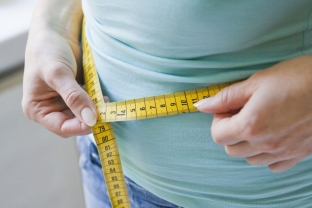There are many reasons why you can't lose weight. One of them – insulin resistance – a hormone whose main function is to transport glucose into cells for use or storage as glycogen. In the case of excessive intake of carbohydrates in the body, glycogen stores are overflowing, and glucose, under the action of insulin, begins to be deposited in the form of fat. A chronic rise in insulin levels in response to excess blood glucose can lead to the development of insulin resistance. It will not be possible to determine whether your body is resistant to the action of this hormone on its own, however, there are some symptoms that may indicate the presence of this problem and the need to contact a specialist.
What diagnostic criteria are used to detect insulin resistance
To be tested for insulin resistance, you need to see a doctor. The specialist will look for the following diagnostic parameters that may be indicative of insulin resistance:
- Waist circumference (if this figure is more than 80 cm for women and more than 94 cm for men).
- Fasting blood glucose (if it is above normal, 70-100 ml/dl is considered normal).
- Fasting insulin (resistance indicator – elevated fasting insulin, i.e. more than 10 µIU/ml).
- Glucose tolerance (performed if diabetes or hypoglycemia is suspected and involves multiple blood draws after glucose solution is taken).
Doctors recommend checking blood sugar every year for people who are overweight or have a family history.
Below estet-portal.com will review:
- symptoms;
- factors;
- methods to solve the problem.
Symptoms of Insulin Resistance: When to See a Doctor
The following are symptoms and risk factors associated with insulin resistance. The more checkboxes you tick, the more likely your body is not responding to insulin properly:
- Genetic predisposition to diabetes, obesity, heart and vascular diseases, strokes.
- Frequent cravings for sweets.
- Frequent feeling of hunger, tendency to overeat.
- Weight gain from eating small amounts of food.
- Fat deposits mainly in the waist area.
- Hyperpigmented skin growths on the neck, chest, underarms.
- Irregular menses.
- . High triglycerides.
- Low HDL ("good" cholesterol) – below 35 mg/dl.
- High LDL ("bad" cholesterol) – above 130 mg/dl.
- High blood pressure.
- Waist circumference greater than 80 cm for women and greater than 94 cm for men.
- Carbohydrate cravings.
- Inability to limit oneself in food.
- Headaches, nausea, anxiety, which disappear after eating.
- Hypoglycemia.
- Frequent tiredness after dinner.
- Body mass index of 30 or more.
- Overweight (minimum 7kg).
 Factors that contribute to the development of insulin resistance
Factors that contribute to the development of insulin resistance
There are a number of factors that can contribute to the development of resistance to
insulineating a lot of carbohydrate foods: processed foods, sugary drinks, corn syrup, etc.;- lack of quality proteins in the diet;
- lack of healthy or excess of unhealthy fats in the diet;
- not eating enough fiber;
- stress;
- hypodynamia;
- liver disease;
- entry of toxins into the body;
- ageing;
- oxidative stress.
- In addition to weight gain, excess insulin is also fraught with deterioration of well-being: weakness, impaired concentration, excessive sweating, cognitive decline, heart palpitations.
Tracking Insulin Resistance: 3 Essential Steps
Because insulin resistance can lead to type 2 diabetes, obesity, and cardiovascular problems, this problem needs to be detected and corrected early. This will help lifestyle changes. However, the following 3 steps will also be helpful in preventing insulin resistance.
Step 1 – food
Avoid processed foods, saturated fats and fast carbohydrates in your diet. Try to eat mostly fresh foods, lean meats, fish rich in healthy fats, legumes, whole grains.
Step 2 – physical activity
Physical activity is essential for both insulin resistance and its prevention. Muscle tissue is metabolically active, that is, during muscle work, glucose is actively burned, and then – fat. Remember that it is best to select an exercise regimen after consulting a doctor, who will determine the most optimal level of physical activity based on your state of health.
Balanced diet, physical activity, healthy habits – best protection against insulin resistance.
Step 3 – habits
As far as habits are concerned, it is not only about the abuse of alcohol and smoking (which must be abandoned). Try to develop good habits: walk in the fresh air every day (at least 30 minutes), drink enough water, get enough sleep for your body, learn to cope with stress.
Read also:
Fat deposits – result of imbalance of insulin and glucagonRemember that our health is very much in our own hands: even if we have a genetic predisposition, we can significantly reduce our risk of developing diseases, including those associated with insulin resistance, if we take care of our bodies every day.






Add a comment